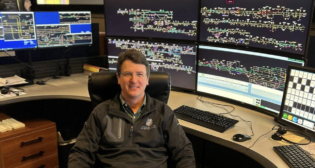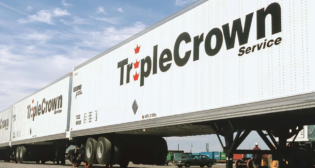
STB Sets Gulf Coast Hearing, But Amtrak Loses Pre-Hearing Round
Written by David Peter Alan, Contributing Editor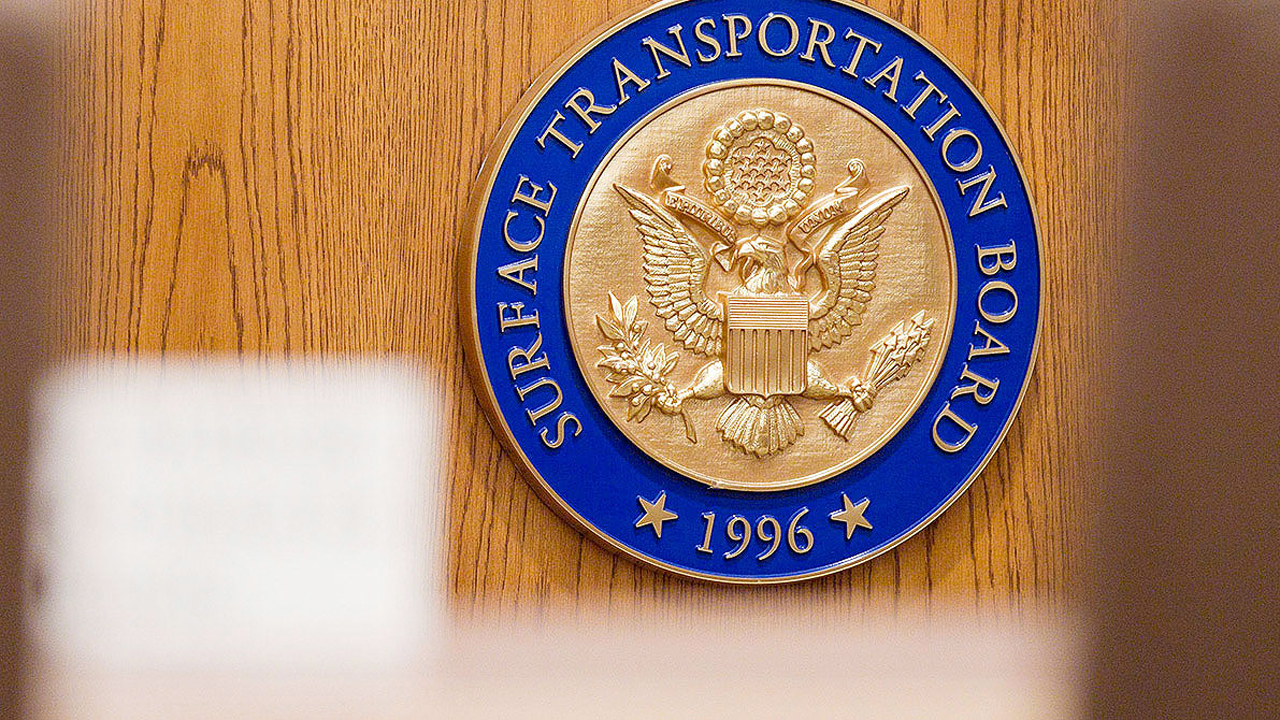
Decision Day draws closer in the tussle between Amtrak and potential host railroads CSX and Norfolk Southern (NS) before the Surface Transportation Board (STB) over whether or not there will be passenger trains running between New Orleans and Mobile in the near future.
STB on Feb. 1 issued a notice that hearings are coming up, and gave potential commenters a narrow window of time to register. Meanwhile, the Board also issued a pre-hearing ruling about procedure and confidentiality, and it looks like Amtrak has lost this round.
The upcoming public hearing regarding Amtrak’s application to operate Gulf Coast service will be held in two phases. The first phase consisting of public comments—many have been submitted via filings, STB said—will begin on Feb. 15, 2022, and will be followed by a pre-evidentiary hearing conference with the parties, phase two. The evidentiary hearing will be March 9, 2022.
The window of time that the STB is allowing for commenters to register is short. Requests to speak must be filed no later than Feb. 7. Directions for filing requests are contained in the notice. Persons who cannot be accommodated on the first day will be heard on the following day. The caption of the case is APPLICATION OF THE NATIONAL RAILROAD PASSENGER CORPORATION UNDER 49 U.S.C. § 24308(e) – CSX TRANSPORTATION, INC., AND NORFOLK SOUTHERN RAILWAY COMPANY and its Docket Number is FD 36496.
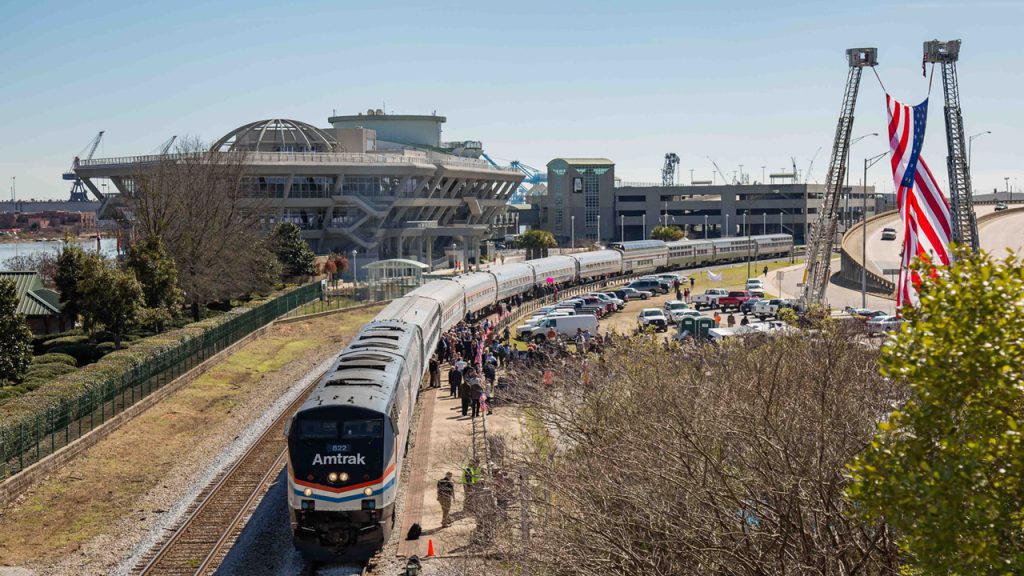
Decision Preview?
The bigger news came on Jan. 28. It was a pre-hearing decision posted on the agency’s website (download below) that appears to reveal a glimpse about how the decision might go. Railway Age has reported extensively on the operational, technical and legal aspects of the matter. Perhaps its most-novel and important feature is that Amtrak is attempting to initiate new service between a city it serves and one that currently has no passenger trains. The last time a train ran between New Orleans and Mobile was the tri-weekly Sunset Limited that ran to Orlando, Fla., from 1993 until Hurricane Katrina devastated the Gulf Coast in 2005 (it has operated L.A.-New Orleans since then). The storm knocked out all service to and from the Crescent City, but the trains between there and New York, Chicago and Los Angeles eventually came back. The train going east never did. Now Amtrak has a shorter goal: two daily round-trips along the Mississippi Gulf Coast to Mobile, a ride slated to take about 3-1/2 hours from end to end.
Local Mississippi officials and Sen. Roger Wicker (R-Miss.) want the trains. Most other Republicans in Alabama do not, and neither do the Port of Mobile and, presumably, the railroads who would host the proposed service. CSX (CSXT in STB filings) owns most of the railroad over which the trains would run. NS (NSR in STB filings) only has a short segment of track in New Orleans that would be used. So the battle lines have been drawn ever since Amtrak announced early last year its intention to inaugurate the service, and the opponents—Alabama officials and the potential host railroads—are already winning the skirmishes. Amtrak wanted to start service by the beginning of this year, and now can’t be sure if it will ever run.
The digest of the decision said: “This decision (1) grants a request to intervene in this proceeding filed by the Alabama State Port Authority and its rail common carrier operating division, Terminal Railway Alabama State Docks, (collectively, the Port); (2) denies as moot the National Railroad Passenger Corporation’s (Amtrak’s) motion for clarification of the Port’s status in the case; (3) denies as moot Amtrak’s motion to strike the Port’s reply evidence; (4) denies Amtrak’s request to file its reply evidence publicly, without redactions or a confidential designation; and (5) denies as moot Norfolk Southern Railway Company’s motion to have Amtrak add confidentiality designations and refile its reply evidence.” The purpose of the ruling was to dispose of the pre-hearing motions and decide the issues raised in them; a large amount of motion practice, which is an indication of how vigorously the parties are willing to fight.
The decision steepened the slope of Amtrak’s uphill climb. “America’s Railroad” has a new official adversary: the Port of Mobile. After reviewing the procedural history, STB wrote: “The Board finds that the Port satisfies the standard for intervention, as the issues it addresses are reasonably pertinent to, and do not unduly broaden, the issues already presented. Therefore, the Board will grant the Port’s request to intervene. The Port clearly has an interest in this proceeding, given that it uses the CSXT main line to switch freight traffic between the Port’s public seaport terminals and its yard on the other side of the CSXT main line. Moreover, the Port has already filed evidence and argument…” (citation omitted). The Port of Mobile is now a party, so the motions underlying Amtrak’s claim that the Port is not a party were denied as moot.
Are Freight Ops Confidential?
The other important issue concerned potential confidentiality of information about CSX’s freight operations on the line at issue and in Mobile.
The document summarized Amtrak’s argument this way: “Amtrak states that it requested that CSXT and NSR revisit their designation of certain highly confidential materials, specifically maps and past timetables related to CSXT operations and data related to NSR rail operations. Amtrak argues that the disclosure of this historical train operating data, train movement data, train counts and track drawings would not cause serious competitive harm to CSXT or NSR, and any claim of competitive harm is purely speculative. Amtrak claims that the information contained in the disputed materials is already available to the public, arguing that a person or camera stationed along CSXT or NSR’s rail lines could record this information by observing the trains as they move along the lines” (citations omitted).
It then summarized the arguments made by NS and CSX: “In reply, CSXT and NSR argue that Amtrak has identified no prejudice that would justify public disclosure, since Amtrak’s outside counsel and consultants have access to the disputed materials under the protective order. CSXT and NSR also argue that federal law and Board precedent protect from public disclosure documents, data and information that reflect the movement of trains and railcars on a rail carrier’s network. In addition, CSXT and NSR dispute Amtrak’s contention that this train movement data is already publicly available and observable and argue that this information is commercially sensitive because a third-party could use the information to determine the identity and location of CSXT’s or NSR’s customers, as well as the car volumes and commodities going to and from each customer. Finally, CSXT and NSR argue that they need not wait for harm to occur before designating material as highly confidential” (citations omitted).
The Board ruled against Amtrak on that issue: “The Board finds that the train movement data at issue here is the class of information that the Board has previously allowed parties to designate as highly confidential pursuant to a protective order. See, e.g., Total Petrochemicals USA, Inc. v. CSX Transp., Inc., NOR 42121, slip op. at 3 (STB served June 23, 2010) (approving protective order defining highly confidential information as including shipper-specific rate, cost or traffic data, or other competitively sensitive information). The train movement data is also not publicly observable because, as CSXT and NSR state, railroads maintain a variety of train movement data sources, which far exceed what could be obtained through trackside observation. … In addition, as CSXT and NSR state, the train movement data could be used to determine the identity and location of their customers, to obtain customer-specific information such as car volumes, and to analyze their business and operations strategy.”
Blaze’s Take

Railway Age Contributing Editor Jim Blaze—an independent rail economist with a telemetric background—strongly disputes the contention that the information Amtrak would need is highly confidential. Earlier in his career, Blaze had experience tracking such movements. When he was starting out as an Illinois DOT employee, he did “windshield studies” to measure traffic volumes on the railways in Chicagoland for a local Metropolitan Planning Organization (MPO). His team later confirmed, through discussions with railroad executives, that these rudimentarily gathered rail-segment volume and congestion factor results were highly accurate. Later, in the 1990s, he was Chair of the Board of Amtech Logistics, a company that kept track of freight train movement at the car-by-car movement level by using scanner-captured data from the Radio Frequency Identification (RFID) tags. That still-used AEI automated scanning technology today reveals the numbers of each car on each passing train, and the train length and the train passing speeds. That is exactly the type of information required for a congestion study and the examination of train conflict correction capital plan options. Accuracy is typically in the 99% range when using scanners.
Blaze told Railway Age: “We could 30 years ago—and still today—identify every car on the train by its standing order in the consist. The only captured commercial intelligence is the car initial number and type, which is perfectly visible to any informed observer from trackside. Nothing is revealed about the rates charged, the high level of STCC (Standard Transportation Commodity Code) info, or about the actual beneficial cargo shipper or receiver—the actual customer that the regulators want to protect.
“The tag data can be captured by using either low-cost portable or higher-cost fixed RFID tag scanners. It is faster and more accurate than using either a clipboard visual collection process or available recording video technology. The process mimics the old windshield survey method. And the scanners can be stationed at a public grade crossing, instead of on the property owned or controlled by the railroad. Even a railfan who enjoys car-spotting as a hobby could do it. The scanner device uses radio frequencies to interrogate the tags on the sides of a freight car, passenger car and any locomotives, and thus captures very accurate track segment movement patterns. There is also video technology that could serve the same purpose.”
Blaze added that Amtech Logistics, some 30 years ago, was a partnership venture owned by Conrail, Union Pacific and NS—together with the original RFID tag innovator, Amtech. Blaze also said: “The railroads—including NS, CSX and Amtrak—continue today using this data collection for cars and locomotives in interchange service. They can enrich the scanner ‘reads’ by matching them with more proprietary waybill data, which is of course more sophisticated than merely counting cars.” But for the purposes of a multiple-use congestion and remediation report, that enrichment task is not necessary. Importantly, the core movement data that even the STB ought to be interested in reviewing does not require any special grade crossing scanning or windshield survey process. It is already being collected every day.
It’s not clear if this issue was raised before the STB, but it appears that NS is aware of the technology and could, therefore, be stopped from claiming that what it would reveal could truly be confidential information.
Blaze concluded that “a person trained in commercial intelligence gathering techniques—even without access to enriched information—could put together an intelligence package about the rail freight commercial activity in this disputed Gulf-market area that would probably reveal more than the STB or the railroad wants to admit. Objecting to these kinds of train and speed and congestion data sharing is in marked contrast to sharing truck counts along the highways. No one feels threatened by such pattern counts. And the truckers are not a niche market. Truckers dominate most freight flows — including in this Interstate-10 vs. CSX/NS rail corridor. Why are the railroads so obsessed about protecting some undefined proprietary interest remains a technical mystery to me as an experienced multi-modal strategic planner.”
In essence, the use of the RFID technology to track the trains amounts to “trackside observation.”
Questions Abound
What does Amtrak need to know that CSX and NS may not want to reveal? The proposed shared-use corridor issue here (at least officially) is about capacity, and the amount of effort it would take and money it would cost to create enough additional capacity along the line and in Mobile (possibly including at the Port) to accommodate the proposed service. If the sophisticated “trackside observation” that Blaze described can reveal when the trains run and how long they are, and their actual patterns of train speeds, then that could be enough information for anybody with the appropriate skill to learn what they need to know to determine accurately what could be done to determine the necessary capacity and the engineering costs of the project options. And no shipper, receiver or railroad needs to reveal any highly classified competitive facts.
There is a policy consideration that the STB appears to have missed in its analysis that could hinder efforts to establish new passenger services around the country, whether sponsored by Amtrak or somebody else (such as a non-Amtrak corridor within a state, but under state sponsorship). If a potential host railroad can claim trade-secret protection for information related to freight train movements (origin, destination and time), it could be extremely difficult for Amtrak or another sponsoring agency to plan affordable projects that would be designed to create the additional capacity the proposed new start would need. Without utilization data, they could be forced to overbuild and overspend.
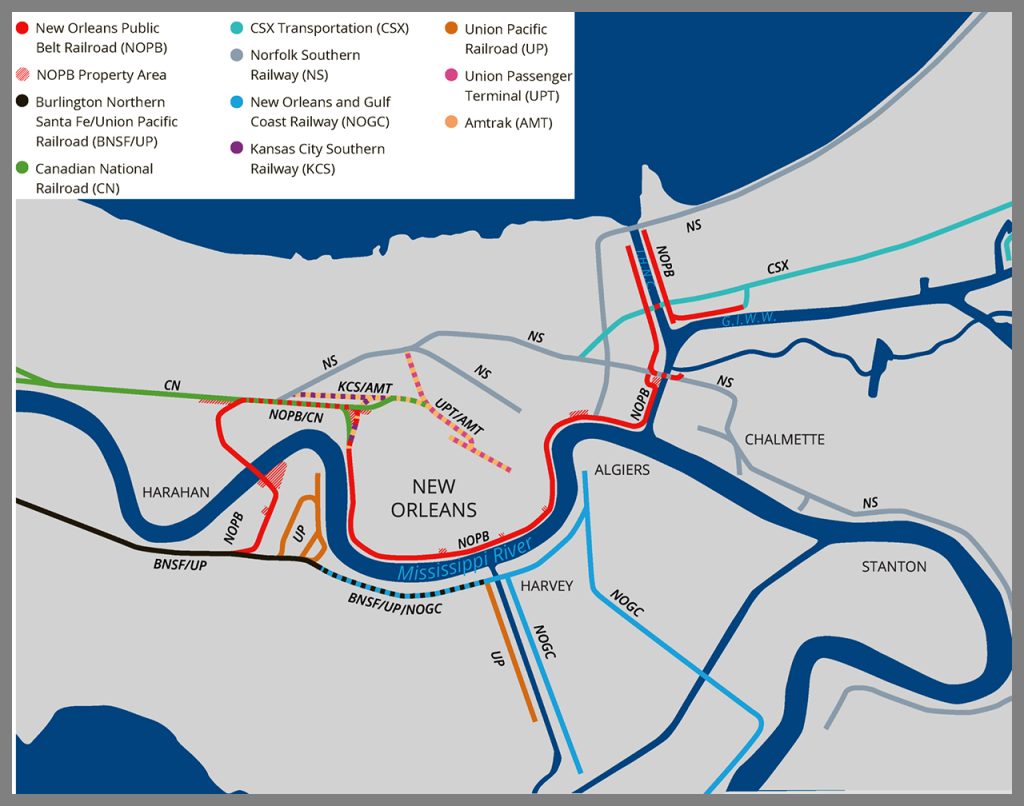
The overall history of the proceeding raises another question: Why is NS so heavily involved in this case? CSX has plenty of “skin in the game” with much of the proposed Gulf Coast service running over its lines; even the Port of Mobile, which has intervened, is at the end opposite New Orleans. The proposed new service would use Amtrak’s Union Passenger Terminal in New Orleans. Trains would operate over NS trackage for a short distance, then transfer to CSX for the duration of the trip along the Gulf Coast to Mobile (see map above). Existing Sunset Limited trains arrive in New Orleans from the West on the BNSF/UP shared line.
The only answer for this conflict that appears to make sense is that the potential host railroads are making their stand here. This is the first time that Amtrak has gone before the STB for permission to move forward with an expansion of its current system. Amtrak is not pushing to go all the way to Jacksonville and connect with southbound trains within Florida or northbound trains through the Carolinas and to New York and other northeastern destinations. But there are still plans to go somewhere new. Many of the proposed routes on Amtrak’s Connect US initiative are longer (see map below), but this is the one Amtrak wants to build first, so it will be the one that sets the precedent.
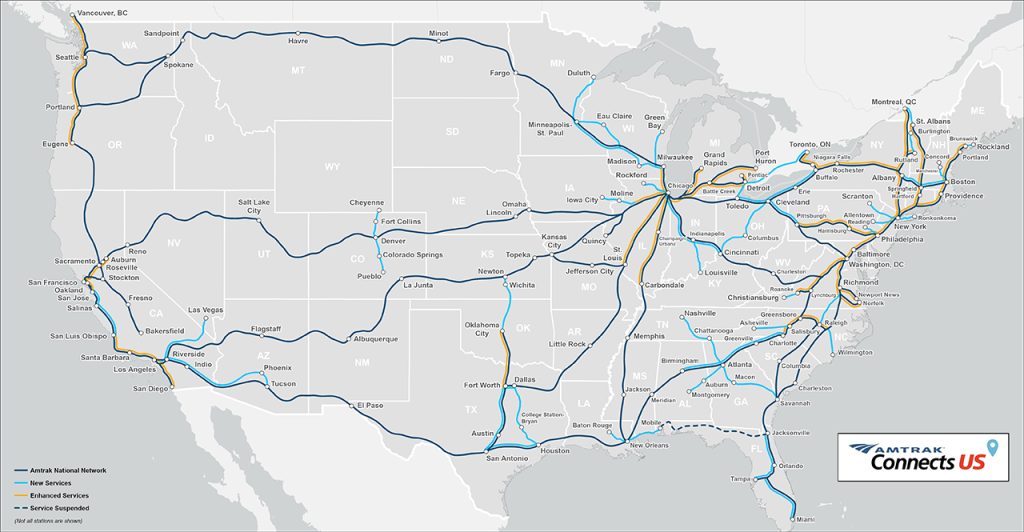
Additionally, NS does not accommodate many Amtrak trains as a host railroad. There is the Crescent route between the Northeast and New Orleans, the Pennsylvanian between Harrisburg and Pittsburgh, the portion of the Capitol Limited route west of Pittsburgh (which includes the part of the Lake Shore Limited route between Cleveland and Chicago), segments in Virginia (between Roanoke and Alexandria, and between Petersburg and Norfolk), and with a few short segments elsewhere. There are a few places where Amtrak wants to run state-supported trains by 2035, but not many of those expansion routes would run on NS. So why is a railroad that would not participate much fight this battle so fiercely?
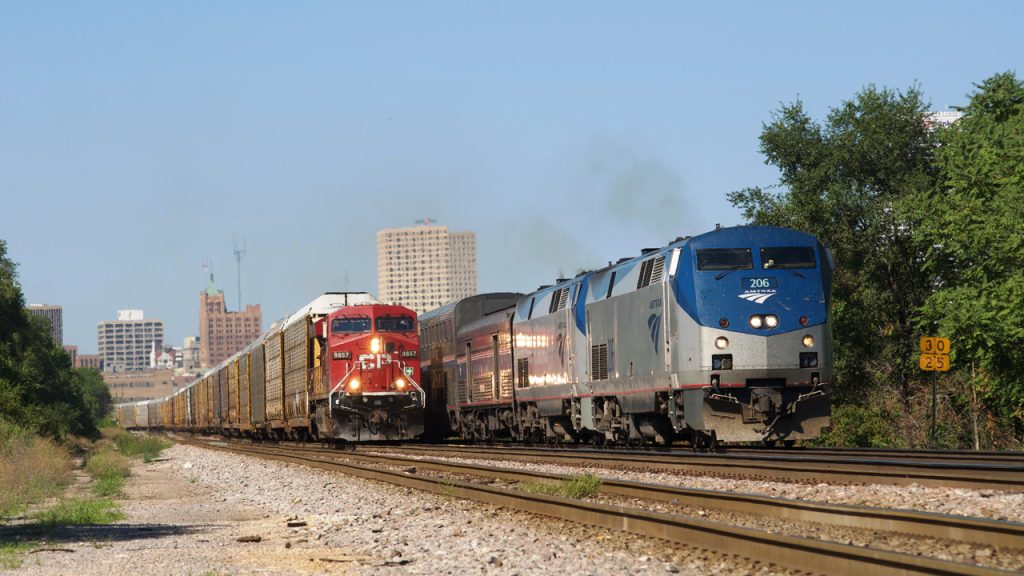
It appears that most potential host railroads (Canadian Pacific and Kansas City Southern the exceptions) want to avoid the “slippery slope” of accommodating an Amtrak train somewhere new, and thus setting a precedent for allowing Amtrak trains elsewhere, at least not at a cost that Amtrak or state sponsors could afford. In my June 2021 commentary—“Is Amtrak’s 2035 Map Riding on the Surf Board?”—I argued this, and little has changed. I wrote: “The eventual results and the procedural precedents associated with the Mobile matter could be repeated dozens of times in other states between now and 2035, or even farther into the future. Will the STB, with the help of the FRA and other government entities, be able to establish a process for adjudicating disputes between Amtrak (or a state wishing to establish a new train or corridor) and a potential host railroad concerning infrastructure and its costs? If so, that may mean more new trains beginning to roll sooner than the potential host railroads would like, even though probably not as quickly as train-starved potential riders would like.”
I stand by that opinion. The freight railroads spent 20 years getting rid of their passenger trains and another 50 years essentially without them, because Amtrak runs so few routes and is essentially precluded from running more that go long distances. Whatever the merits of the Connect US plan for expansion between now and 2035 may be, Amtrak wants to establish some state-supported trains and corridors, and this is the opposite direction of the one that the host railroads strongly appear to desire. CSX claims a cost to build the necessary Gulf Coast infrastructure that is 19.5 times as much the FRA’s estimate. That is too wide a gap to be bridged, so somebody will win and somebody will lose. Amtrak has lost some battles, but the war is not yet over. If Amtrak wins, it’s a start toward an expanded network. If not, the segment of the American people who want to get on a train and go somewhere will lose, too.

David Peter Alan is one of America’s most experienced transit users and advocates, having ridden every rail transit line in the U.S., and most Canadian systems. He has also ridden the entire Amtrak network and most of the routes on VIA Rail. His advocacy on the national scene focuses on the Rail Users’ Network (RUN), where he has been a Board member since 2005. Locally in New Jersey, he served as Chair of the Lackawanna Coalition for 21 years, and remains a member. He is also a member of NJ Transit’s Senior Citizens and Disabled Residents Transportation Advisory Committee (SCDRTAC). When not writing or traveling, he practices law in the fields of Intellectual Property (Patents, Trademarks and Copyright) and business law. The opinions expressed here are his own.

